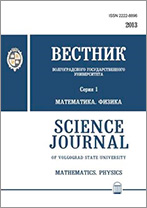|
Computer modelling
Recrossing-algorithms for numerical simulations of bimolecular photochemical reactions in the framework of the extended integral encounter theory
C. V. Feskov
Volgograd State University
Abstract:
Integral encounter theory (IET) is the universal tool for description
of bimolecular chemical reactions assisted by diffusive mobility of
the reacting particles in liquids [3; 4]. The kernels of IET integral equations allow to
take into consideration the influence exerted by different chemical
processes in multistage reaction on each other. The memory effects
modelled by the IET equations are the result of evolution of the
reacting pairs over the interparticle distances. When applied to
processes of fluorescence quenching of photoexcited fluorophore
molecules by electron transfer to the quencher molecules, the
standard formulation of IET suppose the rate constants of thermal
electron transfer to be known for the reactants separated by any
given distance $r$ [4]. Some stages of
photochemical reaction can however proceed in non-equilibrium
conditions over the nuclear degrees of freedom of solvent and the
reacting particles, so that notion of the thermal rate constant
become uncertain.
New approaches proposed in [7; 8]
allowed to extend the IET to nonthermal electron transfer reactions
by means of expansion of the configuration space and introduction of the
auxiliary reaction coordinate $q$ relevant to solvent polarization.
Such extension made it possible to refuse the concept of the pair
rate constant $W(r)$ and to utilize the more general concept of the
intrinsic rate of electronic transitions at the term crossing point
$K(r,q)$.
Within the extended integral encounter theory (EIET) the multistage
bimolecular reaction is described by a set of integro-differential
equations for the populations kinetics of electronic and vibrational
states of the system. From computational point of view, the main
difficulty of EIET simulation can be attributed to calculation of the
integral kernels. Evolution of these kernels in time is governed by a
set of parabolic differential equations coupled to each other through
a number of delta-type source/sink terms. These diffusive equations
determine pair correlation functions for reactants in the space of
solvent polarization modes and inter-particle distances between the
reacting particles. It should be noted that dimensionality of this
space is directly determined by number of solvent relaxation modes.
In this paper new effective methods for numerical solving of the EIET
equations are proposed. These methods are based on the recrossing
algorithms of the Brownian simulation technique [1].
These algorithms have already shown their high performance in models
with several solvent relaxation modes, in chemical reactions with
participation of many electronic and vibrational degrees of freedom,
as well as in simulations of the transient absorption dynamics in
non-equilibrium photochemical systems. Future potential of the
proposed algorithms is also tied up with possibilities to utilize
them in computational systems with hybrid (CPU+GPU) architecture.
Keywords:
computer simulation in chemistry, Brownian simulations, recrossing-algorithms, extended integral encounter theory, bimolecular reactions.
Citation:
C. V. Feskov, “Recrossing-algorithms for numerical simulations of bimolecular photochemical reactions in the framework of the extended integral encounter theory”, Vestnik Volgogradskogo gosudarstvennogo universiteta. Seriya 1. Mathematica. Physica, 2015, no. 5(30), 61–71
Linking options:
https://www.mathnet.ru/eng/vvgum80 https://www.mathnet.ru/eng/vvgum/y2015/i5/p61
|

| Statistics & downloads: |
| Abstract page: | 135 | | Full-text PDF : | 52 | | References: | 40 |
|




 Contact us:
Contact us: Terms of Use
Terms of Use
 Registration to the website
Registration to the website Logotypes
Logotypes








 Citation in format
Citation in format 